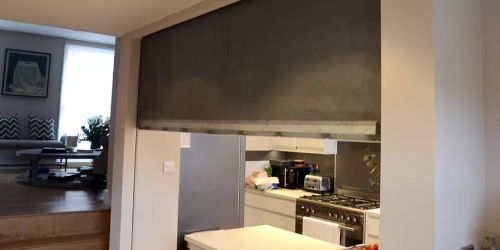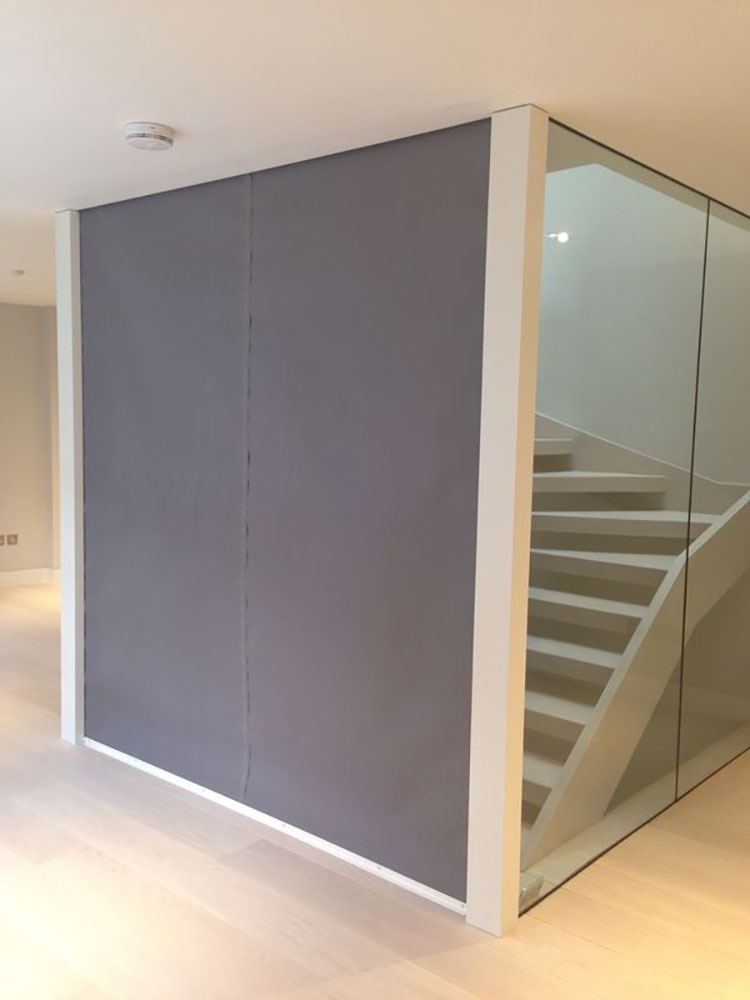In the face of an unfortunate fire outbreak, the most heart-rending fact remains – most fire-related deaths are not directly caused by the flames but by the deadly inhalation of toxic gases.
Because of this, we need more than just firefighting equipment; we need proactive measures. That’s where in-built fire barriers come into play. A standout among these protective measures is the fire curtain. These barriers dramatically reduce the spread of flames and smoke, two major culprits in fire-related fatalities.
So, what is this life-saving innovation?
What Are Fire Curtains?
A fire curtain is a device designed to halt the spread of fire and smoke in a building. It’s made from heat-resistant materials like fibreglass and aramid. These curtains are engineered to descend automatically in response to a fire alarm signal, creating a fire-resistant barrier.

The Components of a Fire Curtain
Fire curtains aren’t just fabric; they combine various fire-resistant materials that form a vital part of a building’s fire protection system. Here’s a quick breakdown:
- Fire-resistant fabric: This is the heart of the curtain, standing strong against fire and preventing it from spreading. This fabric is often made from materials like fibreglass, amorphous silica, or aramid (also known as Kevlar), each designed to withstand high temperatures.
- Guide rails: These act like tracks, guiding the curtain as it descends to ensure it lands in the correct position.
- Control system: This is the brain of the curtain, controlling its operation and typically synchronised with the building’s fire alarm system.
Remember, fire curtains are not fire shutters. These two serve different roles in fire safety. If you’d like to learn more about the differences, please read our blog post on “fire shutters vs fire curtains”.
Types of Fire Curtains
Alongside this, there are several types of fire curtains. Each aimed at fulfilling unique requirements:
- Vertical Fire Curtains: The most common type, these curtains drop vertically from above a door or window, forming a simple yet effective fire barrier.
- Horizontal Fire Curtains: Ideal for wider, open spaces, these curtains extend horizontally across the ceiling.
- Concertina Fire Curtains: Perfect for areas with limited ceiling space, these curtains fold compactly when not used.
Why Choose Fire Curtains?
Over the years, fire curtains have gained popularity, particularly in the face of evolving architectural designs. With the increasing adoption of open-plan layouts in commercial settings, traditional fire shutters are less practical. On the contrary, fire curtains blend seamlessly into modern aesthetics without compromising safety.
How Do Fire Curtains Work
When discussing how fire curtains work, it’s essential to understand their connection with a building’s fire detection system.
Fire curtains are typically installed in diverse areas, mainly where walls are absent, such as open-plan spaces, including large office layouts or spacious commercial venues.
When a fire is detected, the system triggers the curtain’s release. As a result, the curtain descends, creating a robust physical barrier against the spreading flames.
The function of a fire curtain is primarily to provide containment. It hinders the spread of fire, keeping it confined, which helps mitigate damage and provides vital time for evacuation and emergency response.
The Importance of Fire Curtains

Role in Fire Safety
Fire curtains are instrumental in enhancing fire safety. They are engineered to contain a fire within certain areas, thus reducing potential damage and increasing overall safety.
A startling report reveals that thousands of public buildings in England are breaching fire safety regulations, underscoring the role of fire curtains.
By controlling the rapid spread of fire and smoke, these devices can buy precious time for building occupants to escape, turning a potential catastrophe into a manageable situation.
Impact on Containment and Compartmentalisation of Fires
Fire curtains work to compartmentalise a building during a fire incident effectively. They slow the blaze’s spread and limit its access to additional oxygen. This ability to contain a fire not only minimises damage to a building’s structure but also aids in quicker extinguishment of the fire.
Influence on Smoke Control
The recent decline in fire safety audits places more responsibility on building owners to enhance fire safety. Fire curtains are an essential tool for smoke control in this regard.
Particularly when paired with other smoke management systems, they can efficiently help control the spread of deadly smoke during a fire incident. Smoke often poses a greater threat than the fire itself, making the ability of fire curtains to manage it of vital importance.
Benefits of Evacuation Procedures
In 2022, the UK experienced 152,608 fires. In such instances, fire curtains play an essential role in evacuation procedures. Properly installed, they can create safer exit routes, providing a clear path away from danger.
By containing the fire and smoke, fire curtains increase the chances of a successful evacuation and significantly decrease the potential for injuries and fatalities. It’s a testament to their importance that their installation can mean the difference between disaster and a controlled response.
Fire Curtain Regulations & Standards
Understanding the function and benefits of fire curtains is only the beginning. It’s equally essential to comprehend the fire curtain regulations and standards that govern their manufacture and use.
These regulations ensure that every fire curtain installed meets the strict safety and performance measures that make it effective in a fire emergency.
Relevant Safety Standards for Fire Curtains
Every fire curtain in the UK must adhere to BS 8524-1:2013. This is a critical standard detailing the specifications for active fire curtain assemblies. It ensures that these safety devices can perform their function efficiently when the need arises.
Alongside this standard, other specific regulations might come into play based on a curtain’s intended use. For instance, fire curtains used for smoke control often need to meet additional criteria, such as those outlined in BS 12101-1:2005+A1:2006.
Regulatory Requirements
The regulatory requirements for fire curtains are largely dictated by the building regulations set by the UK Government.
For instance, the Building Regulations 2010 – Fire Safety Approved Document B outlines some essential conditions. The document indicates that any product acting as a fire barrier, such as fire curtains, should withstand fire for a defined period without permitting flames or hot gases to pass through.
More specific rules also exist. For example, in premises used for entertainment or assembly, Regulation 14 of the Regulatory Reform (Fire Safety) Order 2005 necessitates safety measures like fire curtains to safeguard escape routes.
In addition to these governmental regulations, the standards of local building control bodies and insurance companies often define the requirements for fire curtain installation and use.
Compliance and Certification Process
Regarding compliance and certification, the Loss Prevention Certification Board (LPCB) and British Standards Institution (BSI) are two key bodies in the UK. They certify fire curtains based on rigorous testing to confirm adherence to national and international standards.
The LPCB, for example, offers certification to fire curtains that meet the criteria outlined in standard BS 8524. To gain certification, curtains are subjected to various tests, including exposure to high temperatures and mechanical operational tests.
Additionally, the BSI Kitemark is a widely recognised symbol in the UK that a fire curtain has been independently tested and confirmed to meet the necessary fire curtain regulations and safety standards.
Navigating the landscape of fire curtain regulations and certifications can seem complex, but as industry professionals, we aim to provide clarity and assurance that our products meet and often exceed these stringent criteria.
Applications of Fire Curtains
Fire curtains are an essential fire safety feature with wide-ranging applications across various settings. Here, we explore how they can contribute to fire safety in different environments.
Use in Commercial Settings
In office buildings, fire curtains play a crucial role in open-plan layouts, offering a rapid response solution that can effectively segregate spaces during a fire, complying with Regulatory Reform (Fire Safety) Order 2005.
Retail stores often opt for fire curtains as they provide a cost-effective and visually less intrusive alternative to fire doors, all while meeting the strict criteria of BS 8524-1:2013.
In theatres and cinemas, fire curtains have a long history. They protect the audience without compromising their view, fulfilling the safety standards outlined by the Building Regulations 2010 – Fire Safety Approved Document B.
Use in Industrial Settings
In manufacturing plants, fire curtains help compartmentalise vast spaces, mitigating the spread of fire and smoke. Their use aligns with the Health and Safety at Work Act 1974 requirements.
Warehouses use fire curtains to safeguard stock and machinery from potential fire damage. They are integral to the fire safety measures stipulated by the Regulatory Reform (Fire Safety) Order 2005.
Use in Residential Settings
High-rise apartments face an elevated fire risk, making fire curtains a vital protective feature. They adhere to the criteria set out by BS 9991:2011 – Fire safety in the design, management and use of residential buildings.
In single-family homes, fire curtains offer additional fire safety, particularly in high-risk areas such as kitchens and garages, complying with Part B of the Building Regulations.
Special Circumstances
Historical buildings benefit from fire curtains as they offer a less intrusive fire safety solution, helping to maintain their unique character while satisfying the requirements of the Historic Buildings and Monuments Commission for England.
In schools and educational facilities, fire curtains provide added protection in large communal areas like halls and dining areas, fulfilling the regulations set out by the Department for Education’s Building Bulletin 100: design for fire safety in schools.
In each of these settings, fire curtain regulations and requirements ensure this life-saving technology’s effectiveness and reliability.
Installation and Maintenance of Fire Curtains
An effective fire curtain is about the product, its correct installation, and diligent maintenance. Here are a few critical aspects you should know:
- Professional installation: The effectiveness of a fire curtain largely depends on professional installation. Installers should have an in-depth understanding of the relevant fire curtain regulations and the specific requirements of the building. This ensures that the curtains will perform optimally when needed.
- Regular inspections: Like all safety equipment, fire curtains require regular inspections to remain in good working order. These assessments should be conducted by a competent person who can identify any issues potentially affecting the curtain’s performance, thereby keeping the fire curtain in compliance with fire curtain requirements.
- Maintenance requirements: The maintenance of fire curtains can vary based on the manufacturer’s instructions. However, all fire curtains should be kept clean and free from obstructions, guaranteeing they can descend correctly during a fire emergency.
Understanding these points is essential in ensuring your fire curtains can provide maximum protection when needed.
Need A Fire Curtain?
Navigating the world of fire safety can be complex, but help is at hand. If you’re wondering, “What are fire curtains?” or considering installing them in your building, UK Roller Shutters is a reliable and professional service provider.
As specialists in the field, we offer a diverse range of fire curtains designed to meet the highest safety standards. Our selection ensures you’ll find the perfect fit for your building’s requirements.
Beyond providing top-quality fire curtains, the dedicated team at UK Roller Shutters can offer expert advice, guiding you to find the best fire safety solutions tailored to your needs. Our commitment extends to ensuring professional installation and providing thorough maintenance services.
When it comes to your safety, don’t compromise. Contact us today for more information. Alternatively, browse all our roller shutter doors to see how else we can help.
